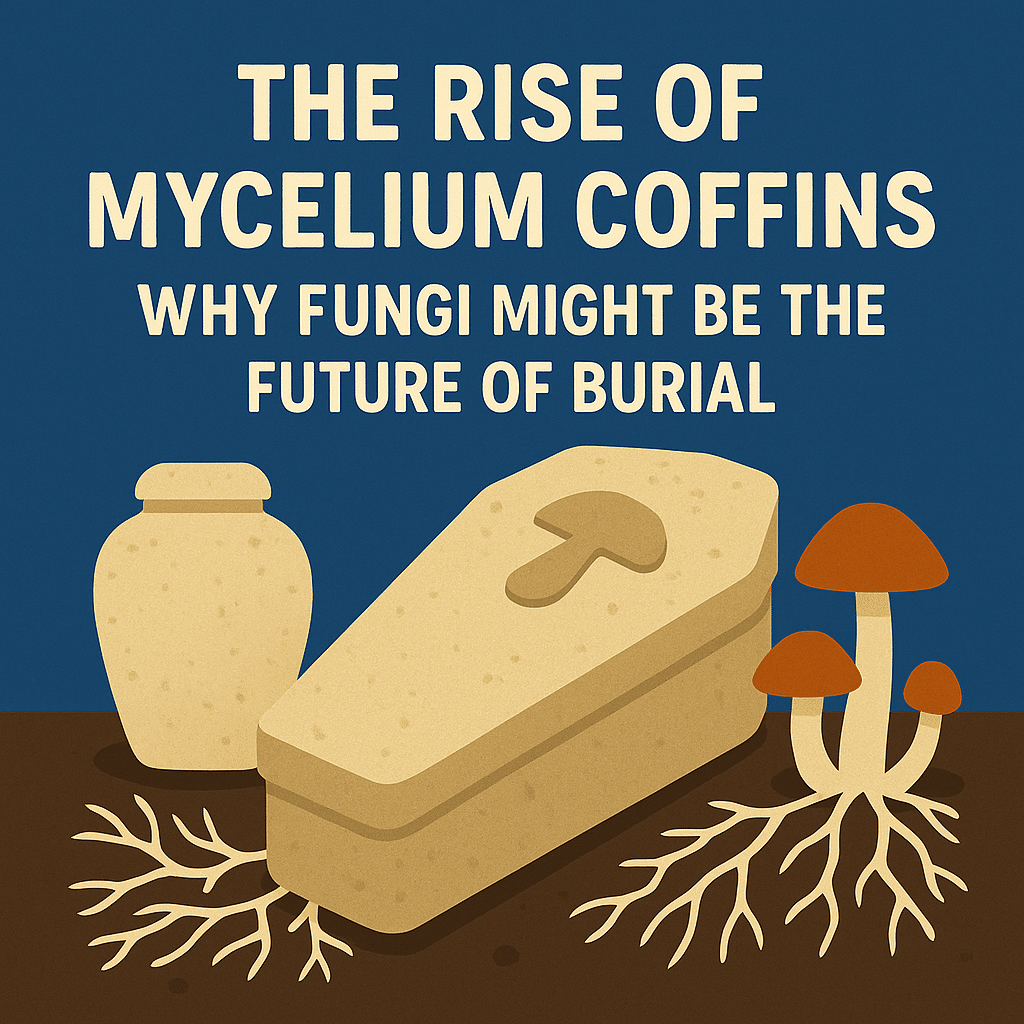There’s a quiet revolution happening underground, literally. In recent years, mycelium coffins have captured the imagination of people looking for a more sustainable, natural return to the earth. Grown from fungi and agricultural waste, these biodegradable burial vessels offer an elegant solution to a growing problem: how do we leave this world without leaving a mess behind?
What Is a Mycelium Coffin?
Mycelium is the root-like structure of fungi, forming dense networks beneath the soil that break down organic matter and nourish ecosystems. A mycelium coffin is created by growing this natural material into a mold, usually reinforced with agricultural byproducts like hemp, flax, or sawdust. The result is a strong, lightweight, fully biodegradable coffin that returns to the earth within 30 to 45 days.
Grown, Not Manufactured
Unlike metal or hardwood coffins, which require extensive industrial processes, mycelium coffins are grown over several days. The fungi are “fed” with organic material and shaped into forms, like human-sized containers or urns, that naturally harden without glues, nails, or chemicals. Once complete, the growth is halted by drying or baking, making it safe and shelf-stable until used.
Why Traditional Burials Are Problematic
Conventional burial practices often involve toxic embalming chemicals, hardwoods harvested from endangered forests, and cement vaults that prevent natural decomposition. Cremation, often seen as a greener alternative, uses up to 92 kilowatt-hours of energy and releases harmful emissions.
The Hidden Cost of Caskets
Every year, U.S. cemeteries bury an estimated 30 million board feet of hardwood, 90,000 tons of steel, and over 800,000 gallons of formaldehyde-based embalming fluid. These materials don’t break down easily, and many never fully decompose, effectively turning cemeteries into landfills with tombstones.
Mycelium coffins offer a much-needed counterpoint. They break down quickly, nourish the soil, and avoid the use of synthetic or toxic materials. In other words, they give something back.
Environmental Benefits of Mycelium Burial
One of the most powerful aspects of mycelium coffins is that they don’t just disappear into the earth. They actively improve it. Fungi are natural decomposers and detoxifiers. When buried, mycelium continues its job of breaking down organic matter, filtering toxins from the body, and replenishing the soil with nutrients.
Carbon Negative by Design
Some companies report that each mycelium coffin absorbs up to 30 kilograms of CO₂, about the same as planting a tree. Because the materials are locally sourced, require minimal energy to grow, and avoid deforestation, their overall carbon footprint is extremely low.
No Trees, No Harm
Unlike wooden caskets, which often rely on virgin lumber and overseas manufacturing, mycelium coffins are created using waste products. That means no trees are cut down and no forests are harmed in the process.
Who’s Making These Coffins?
Companies like Urth Ritual, Loop Biotech, and other innovators around the world are leading the way in fungi-based burial products. Urth Ritual, for example, offers human and pet coffins made from mushroom fiber and organic waste, as well as mycelium urns and cotton burial shrouds dyed with natural pigments.
Imperfection as a Feature
Each coffin is one-of-a-kind, with slight variations in texture and color that reflect its natural origins. In a world of mass production, these imperfections offer something rare: authenticity. They also serve as a quiet reminder that death is not a manufactured event, but a natural one.
Where Can You Be Buried in a Mycelium Coffin?
Mycelium coffins are best suited for green or natural burials, which avoid embalming, metal vaults, or synthetic materials. Dozens of green cemeteries across the U.S., Canada, Europe, and beyond already accept these eco-friendly options. It’s always important to check with your local cemetery or funeral provider before purchasing.
Jewish and Other Religious Considerations
Some mycelium coffins, especially those made without metal or synthetics, meet the requirements of Jewish burial law and are considered naturally kosher. They also align with many indigenous and spiritual traditions that emphasize harmony with nature.
How Much Do Mycelium Coffins Cost?
Prices vary depending on the company and size, but most range between $1,000 and $2,000. While they may cost more than a cardboard casket, they’re typically less expensive than traditional wood or metal coffins. Given their environmental benefits and lower long-term impact, many families view the investment as a meaningful final act of stewardship.
Can You Pre-Purchase One?
Yes. Some companies allow you to purchase a coffin ahead of time and store it safely until it’s needed. Others offer pre-need plans where the coffin is kept by the provider and shipped when the time comes.
Is the World Ready for Mushroom Burial?
More than ever, people are rethinking how they want to be remembered and how they want to return to the earth. Mycelium burial speaks to a generation that values sustainability, authenticity, and a deeper connection to the natural world.
It’s not just a coffin. It’s a living, breathing symbol of renewal. One that transforms a final act into an offering, back to the soil, the fungi, and the planet that made us.
If you have feedback, questions, or ideas for future articles or Information Hubs, please contact us. Your insights help us create valuable content.


